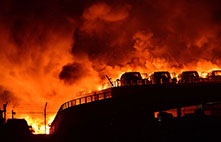City's smelly waterways set to be cleaned by 2018
Updated: 2016-01-27 08:22
By Hu Yongqi(China Daily)
|
||||||||
All smelly and polluted rivers and waterways in Beijing will be cleaned up with the help of recycled water in three years, local authorities said on Tuesday.
Thousands of outlets discharging wastewater have contaminated 141 waterways in the capital, according to the Beijing Water Authority.
This year will see 24 waterways cleaned up in Chaoyang, Tongzhou, Haidian, Shunyi and Daxing districts. Another 33 waterways are scheduled for the cleanup program, according to the authority.
The capital has 425 rivers and waterways with a total length of 6,400 km.
"Last year, we started to build 76 wastewater treatment plants, and 45 have been completed with a capacity to process 950 million cubic meters of recycled water. This year, 1 billion cubic meters of recycled water will be processed to help clean up smelly waterways," Jin Shudong, director of the Beijing Water Authority, told a news conference on Tuesday.

Recycled water is reclaimed from sewage by removing solids and impurities and can be used to irrigate land, recharge groundwater aquifers, or meet other commercial and industrial needs.
By the end of the 13th Five-Year Plan (2016-20), the city is expected to have the capacity to produce 1.2 billion cubic meters of recycled water to improve the ecology, Jin said.
Meanwhile, the authority has built 1,290 km of pipelines to intercept and treat sewage, and another 1,181 km of pipelines are scheduled to be built this year.
Beijing is short of water resources, with only 150 cubic meters per person, less than half of the worldwide standard of 300 cubic meters, which shows the importance of reclaiming wastewater, said Jin.
For him, one key factor in the deterioration of water quality is the growing population. Three years ago, Jin visited Qinghe River in northern Beijing and, to his surprise, the river that was clean in 2008 had already become tainted, he said.
Before 2008, there were only 900,000 residents along the banks of Qinghe, but that number has tripled in five years and many pollutants have been discharged into the water, Jin said.
"Discharge and treatment facilities for polluted water lag behind the growth of population and have caused pollution," he said.
- A glimpse of Spring Rush: little migrant birds on the way home
- Policy puts focus on genuine artistic students
- Police unravel market where babies are bought, sold as commodities
- More older pregnant women expected
- Netizen backlash 'ugly' Spring Festival Gala mascot
- China builds Mongolian language corpus
- Special envoy to visit Laos and Vietnam
- El Nino expected to wreak havoc in S. America well into 2016
- Police officer rescues frightened sloth at corner of busy highway
- US Secretary of State visits Laos, aiming to boost ties
- 2 Chinese nationals killed, 1 injured in suspected bomb attack in Laos
- New York, Washington clean up after fatal blizzard

 Creation of China Daily's Tibetan-style font
Creation of China Daily's Tibetan-style font
 Drone makers see soaring growth but dark clouds circle industry
Drone makers see soaring growth but dark clouds circle industry China's Zhang reaches Australian Open quarterfinals
China's Zhang reaches Australian Open quarterfinals
 Spring Festival in the eyes of Chinese painters
Spring Festival in the eyes of Chinese painters
 Cold snap brings joy and beauty to south China
Cold snap brings joy and beauty to south China
 First trains of Spring Festival travel depart around China
First trains of Spring Festival travel depart around China
 Dough figurines of Monkey King welcome the New Year
Dough figurines of Monkey King welcome the New Year
 Ning Zetao, Liu Hong named China's athletes of the year
Ning Zetao, Liu Hong named China's athletes of the year
Most Viewed
Editor's Picks

|

|

|

|

|

|
Today's Top News
National Art Museum showing 400 puppets in new exhibition
Finest Chinese porcelains expected to fetch over $28 million
Monkey portraits by Chinese ink painting masters
Beijing's movie fans in for new experience
Obama to deliver final State of the Union speech
Shooting rampage at US social services agency leaves 14 dead
Chinese bargain hunters are changing the retail game
Chinese president arrives in Turkey for G20 summit
US Weekly

|

|







